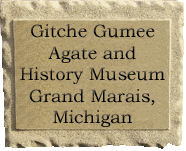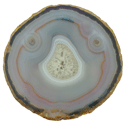MINERAL OF THE MONTH
October 2008: Mexican Opal

Mexican Opal comes from the Magdalena, Jalisco area of Mexico. Historians have determined that the Aztec people used Mexican opal for ceremonial and ornamental purposes between 1200 and the early 1500s when the Spaniards Conquistadors took over the area. It is known by locals as vitzitziltecpal or the “humming bird stone" due to the iridescent similarity to the feathers of the bird. It also has several other local names including fire opal, jelly opal, crystal opal, cherry opal, and girasol. Many ancients believed that the storm god became jealous of the beauty of the rainbow god. As a result, the storm god broke the rainbow, causing pieces of the rainbow to fall to the Earth to become a part of the opal which exhibits the “rainbow-fire” appearance.
After the Spanish took over the area, the source of these opals was lost until 1840 when Sir Jose Maria Siurab discovered the deposits. Mining still continues today, but the number of opals found has dwindled since the peak production in the late 1960s.
All opals are hydrated silicates containing between 3 and 10 percent water. Some, but not all opals, have a “play of color.” This color show results from diffraction and interference of light rays that travel through the spaces between columns of microcrystaline spheres of silica. The diameter of the spheres within any column determines the resultant color. If there is no color, as is true with common opal, there is a random pattern of microcrystaline spheres, and thus, no structure to act as a diffraction grating.
The specimen featured this month was purchased from a small rock shop located just outside of Yosemite National Park during the late 1990s. I had just finished hiking with my friend, Clare Comstock, when she spotted the rock shop. This six pound gem was on display as an example of opal from a Mexican mine operated by the rock shop’s owner. When I saw the specimen, I asked about its availability for purchase. Although the owner said it was not for sale, she finally agreed to part with it as long as I agreed to display it prominently in the museum. Not only have I done that, but now I’m featuring it as the Mineral of the Month.
I have left this specimen raw because of its innate beauty. Plus, opal can be somewhat fragile and has a tendency to develop fine cracks due to dehydration. I only “dress up” and polish rocks if it will increase the value of the specimen. For this beauty, it is not worth the risk.
Gemological Data |
|
| Chemistry: | hydrated silicon dioxide |
| Luster: | vitreous to resinous |
| Hardness: | 5.5 - 6 |
| Crystal structure: | none, it is amorphous |
| Fracture: | conchoidal to uneven |
| Cleavage: | none |
| Density: | 2.15 |
| RI: | 1.42 - 1.43 |
| Birefringence: | none |
Metaphysical Properties
Opal helps with the amplification of your most positive traits, therefore, providing the ability to overcome your lesser attributes. It can also improve your creative flow and maximize your inspiration and imagination. Opal has been used by the Native American Indians and the Australian aboriginal shaman to invoke visions and to facilitate ceremonial “dreamtime.”
Mineral of the Month Archives
May 2007: Rainbow Fluorite
June 2007: Lake Superior Michipicoten Agate
July 2007: Labadorite
August 2007: Rain Flower Agate
Fall 2007: Malachite
December 2007: Nepheline Syenite
January 2008: Native Copper
February 2008: Amazonite
March 2008: Lake Superior Agate
April 2008: Shadow Agate
May 2008: Apohpylite
June 2008: Ocean Jasper
Summer 2008: Marra Mamba Tiger's Eye
September 2008: Mohawkite
October 2008: Mexican opal
November 2008: Prehnite
December 2008: Picture Jasper
January 2009: Sea Shell Jasper
February 2009: Polychrome Jasper
March 2009: Selenite Desert Rose
Spring 2009: Coyamito Agate
July 2009: Obsidian Needles
August 2009: Goethite
September 2009: Banded Iron Formation
Fall 2009: Fairburn Agate
March 2010: Fossilized Dinosaur Bone
April/May: 2010 Kentucky Agate
June 2010: Nantan Meteorite
July 2010: Mookaite Jasper
Aug/Sept 2010: Polyhedroid Agate
Fall 2010: Ammonite Fossil
September 2011: Petoskey Stones
Spring 2011: Petrfied Wood
Winter 2011: Argentina Condor Agate
January 2012: Mary Ellen Jasper
March 2012: Mexican Crazy Lace Agate
June 2012: Moqui Marbles
September 2012: Chlorastrolite Greenstone
March 2013: Jacobsville Sandstone
August 2013: Unakite
November 2013: Skip-an-Atom Agate
April 2014: Tiger's Eye
September 2014: Black Corundum
February 2015: Condor Agate
June 2015: Petoskey Stone
November 2015: Slag
June 2016: Lake Superior Copper Replacement Agates
March 2017: Chert
July 2017: Kona Dolomite
December 2017: Septarian Nodule
Copyright All rights reserved.
Gitche Gumee Museum.
E21739 Brazel Street
Grand Marais, Michigan 49839





